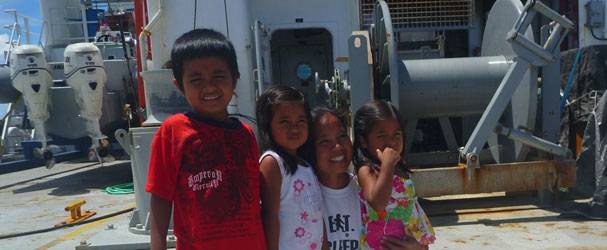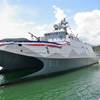Around the Pier: Research and Rescue
A mission to install a weather station in one of the most remote places in the world took on a humanitarian component when Scripps research vessel Roger Revelle took aboard a woman and her three children, who had been confined to a small atoll for more than a month.
Helen Reef is an atoll, a ring-shaped coral reef, which is part of the Hatohobei state in the island nation of Palau located in the South Pacific. Although the atoll is about 15 miles long and six miles wide, only a small sand dune of an island rises above the water, barely 65 feet wide and 1,300 feetlong.
Three Tobians, as residents of Hatohobei are known, live on the island year-round as conservation rangers to protect the near-pristine atoll from foreign poachers and to maintain conservation projects on the thickly forested island.
Last spring the wife of one of the rangers, Grace Sabadoquia, took her three children out to visit their father, hitching a ride on one of the boats that periodically brings supplies to the islanders. The family planned to come back with the same boat when it returned after another voyage, but the steamer never came back. By June, Grace and her three children (all under the age of 10) had been stranded on the island for more than a month.
Shaun Johnston, a Scripps Institution of Oceanography physical oceanographer, was in Koror, the capital of Palau, planning the installation of a remote weather sensing system on Helen Reef. This installation was one of many scientific objectives of a research aboard R/V Roger Revelle, which was working in Palau waters as part of a research project led by Johnston to determine how major currents flow around the islands of Palau. This work, part of a larger program supported by the Office of Naval Research, is characterizing how ocean currents flow around groups of islands, and involves a broad array of observations including mapping the topography of the ocean floor, measuring currents, observing meteorological conditions and obtaining seawater temperature and salinity profiles in closely-spaced grids.
To install the weather station and gather data at Helen Reef, Johnston had begun working with the governor of Hatohobei, Thomas Patris. Patris, who was in daily radio contact with the rangers at Helen Reef, described the plight of Grace and her children and asked whether Johnston and R/V Roger Revelle might be able to help.
A new father himself, Johnston was motivated to help if he could. The ship was scheduled to call on Helen Reef to install the weather station, so it seemed like a simple matter to transport the family back to civilization. However, like almost all major research vessels, RV Roger Revelle is owned by the Office of Naval Research, and its permission was needed. In addition, federal regulations stipulate that, except in exceptional circumstances, only scientific personnel and crewmembers may sail aboard research vessels. To perform this rescue, Scripps needed to obtain permission from ONR and clearance from the U.S. Coast Guard to evacuate Grace and her family from Helen Reef.
Johnston and Eric Terrill, the other Scripps scientist involved in the cruise, contacted Scripps Associate Director, Bruce Appelgate for help obtaining these clearances from the regional head of the U.S. Coast Guard in Guam. Appelgate asked whether the evacuation could be considered a medical emergency, which would justify the rescue.
“Eric told me, ‘Palauans are pretty tough, and they don’t ask you for something unless they really need it,’ “Appelgate said.
On that basis, Appelgate and Terrill were able to work with their ONR contacts to obtain approval from the Coast Guard for a humanitarian evacuation.
Getting permission to pick up the family took about a week. Once they had clearance and the scientists were ready to go, the mission got underway and all objectives — scientific and humanitarian — were completed on July 4.
Soon after leaving Helen Reef, Johnston reported that the family was safely on board, enjoying cupcakes, and declaring that they “never want to leave and have asked in detail how they can be oceanographers too.” Grace and her children were returned to the mainland of Palau grateful to be home after their unexpected adventure.
“This is the first humanitarian rescue that’s taken place during my watch,” Appelgate said. “Scripps ships stand ready to perform humanitarian services when called upon, and we work closely with ONR and other federal agencies to comply with all the regulations involved.” Appelgate added that Scripps research vessels have a long history of conducting outreach and charitable work in ports all around the world, and that “as ambassadors of Scripps and UCSD, we really enjoy the opportunity to share what we’re learning about the ocean and Earth with people in ports that we visit. ”
Governor Patris followed up with a highly complimentary letter to Scripps. “I would like to thank the officers and crew for handling our cargos with care and the passengers with love,” wrote Patris in a thank-you letter to Appelgate. “A weather station has been installed successfully at Helen Island,” he added. “It is the first time in history to know weather in Helen’s Reef while staying in Koror. A glimpse of your research onboard is such a learning experience too.”
“This [rescue] is a great example of how Scripps scientists often go out of their way to take on extracurricular activities that really make a positive impact on the people they work with in the field,” Appelgate added. ”Shaun is a great guy for taking this on and making it happen.”






















